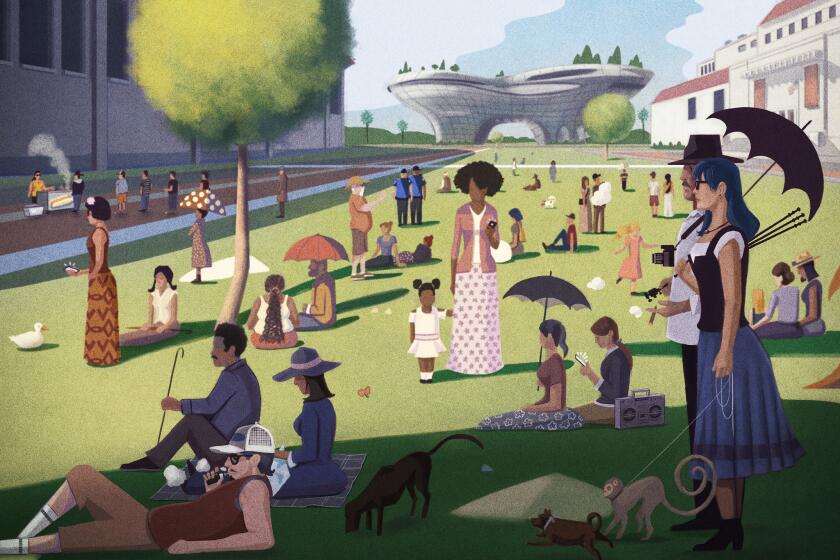Korean American museum design calls for a lush rooftop garden and a sense of mystery
- Share via
The Korean American National Museum has unveiled design plans for its future Los Angeles home — a two-story, 16,900-square-foot building by Morphosis Architects that celebrates Korean heritage while exploring the intersection of Korean and American cultures.
“We talk about being a salad bowl rather than a melting pot,” Morphosis partner Eui-Sung Yi said. “Melting pot suggests you lose your identity. I think we all need to retain our identity, but not at the expense of coming together and embracing other peoples’ identities.”
The firm’s most prominent move is “grafting” a garden and terrace on top of the building with the help of DSK Landscape Architects. The garden’s sculptural forms, which Yi said could be made of pre-cast concrete if budget allows, will echo the thrusting mountains of Korea, while its vibrant plantings, providing much-needed greenery and open space on a block that is dominated by strip malls and mega developments, will contain plants common to Korea such as maple, pine and bamboo, side by side with plants native to California.
The museum, scheduled to open in 2022 in the heart of Koreatown, will have a concrete facade lacking traditional architectural elements like windows and doors (save for a gap where the entry will be) to instill curiosity and mystery. Its grooved patterning will be based on a traditional Korean motif symbolizing, among other things, rebirth and long life, which Yi noted is especially relevant when discussing the long arc of the Korean diaspora. Many of the garden’s plantings, he added, will cover the architecture over time.
Here’s a look at the preliminary plans for Taylor Yard, the former rail yard where the city of L.A. is starting its makeover of the L.A. River.
Beneath the rooftop, the museum will follow the classic courtyard plan of a Korean hanok, or traditional home. With its shifting light shaped by the mountainous forms above, the central courtyard will be circled by an interconnected and flexible ring of galleries, meeting rooms, offices and archival space, plus a cafe and gift shop. The museum is hoping to place large-scale sculptures in the courtyard, and the walls lining the plaza will be movable to create a larger continuous space. Two levels of parking will lie underground.
Los Angeles has the largest population of Korean Americans and the biggest Koreatown in the United States. But until now, it hasn’t had a permanent museum dedicated to celebrating the community’s heritage and creativity.
The museum, which will rise at 6th Street and Vermont Avenue, was founded in 1991 but has had to partner with other cultural institutions to stage events such as showcases of contemporary Korean American artists and an exploration of kimchi in Korean American culture. The museum has raised $15 million for the project, whose construction is estimated at $25 million (with soft costs such as permits, taxes and consultant fees raising the total to $32 million to $35 million). The site, a former Los Angeles Department of Transportation parking lot, will be leased from the city for $1 a year.
“We’re just so excited to be here,” said museum Executive Director Shinae Yoon. She noted that organizers considered other locales like Orange County before choosing Koreatown for, among other things, its concentrated population of Korean immigrants and its urban vibrancy. “It just reinforces the idea that we are a melting pot. That California has brought so many cultures together.”
A psychedelic-hued pavilion straight out of Alejandro Jodorowsky’s “Dune” has landed at the La Brea Tar Pits.
Whether melting pot or salad bowl proves the best metaphor for the museum, the presence of so many people of Korean descent on the Morphosis team was a plus for the museum’s board, Yoon said.
Morphosis’ Yi said his team’s Korean makeup was a coincidence. Yi himself is a Korean American who has worked for Morphosis on and off for 15 years, helping to found the firm’s Seoul office in 1994. He also helped design the Korean Embassy in Tokyo for Korean architects Chang-jo.
Two earlier iterations of the museum were designed by Seoul-based Suh Architects and L.A.-based Gruen Associates. The latter integrated more than 100 housing units into its design. But that plan, intended to help fund the institution’s endeavors, was scrapped in 2018 after being deemed too costly.
The timing of the museum’s opening, Yoon said, is especially important as many first-generation Korean Americans age and their stories potentially are lost. The museum has begun compiling historical resources for its archives and hopes one day to have a permanent art collection. The institution also will provide a focal point for a community, she said, that is renowned for its digital presence but not for bringing its members together in real life.
“So much happens online these days,” Yoon said. “But to have a physical space, and one as beautiful as this, means the world.”
If you live in Los Angeles, perhaps you’ve been to Exposition Park — maybe to catch a Trojans game at the Coliseum, or to see the Space Shuttle Endeavor at the California Science Center, or to let the kids run around the dinosaurs at the Natural History Museum.
The best way to support our coverage of L.A. architecture and design is to become a digital subscriber.
More to Read
The biggest entertainment stories
Get our big stories about Hollywood, film, television, music, arts, culture and more right in your inbox as soon as they publish.
You may occasionally receive promotional content from the Los Angeles Times.











